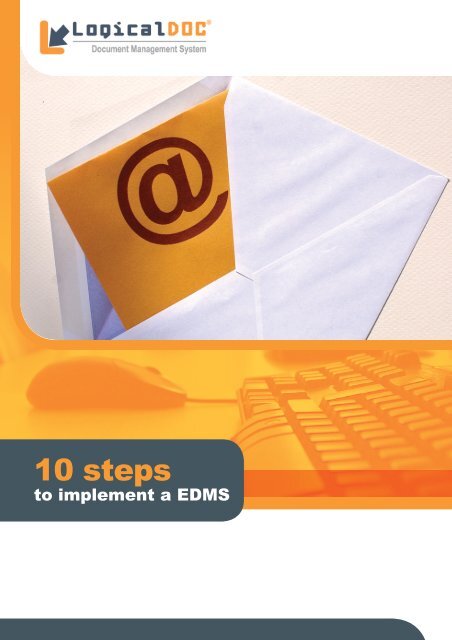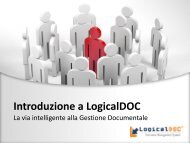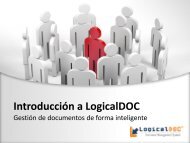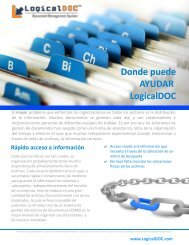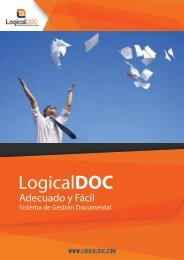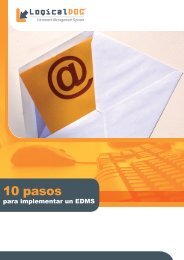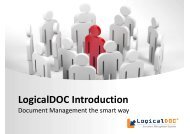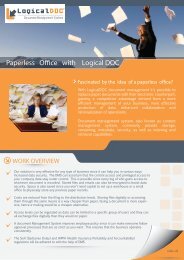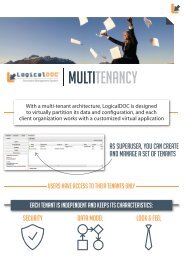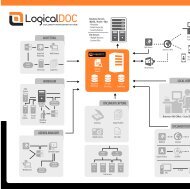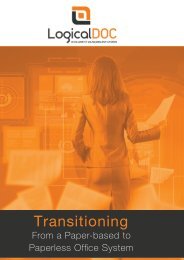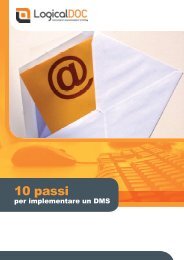10 steps to implement EDMS
You also want an ePaper? Increase the reach of your titles
YUMPU automatically turns print PDFs into web optimized ePapers that Google loves.
<strong>10</strong> <strong>steps</strong><br />
<strong>to</strong> <strong>implement</strong> a <strong>EDMS</strong>
Introduction<br />
In <strong>to</strong>day’s business processes, information plays a key<br />
role. Information is used <strong>to</strong> steer business processes and<br />
<strong>to</strong> provide people the information and instructions <strong>to</strong> do<br />
their job. Most of our information is kept in documents and<br />
it is very important that documents are well managed and<br />
that they are available <strong>to</strong> the right people at the right time.<br />
A Document Management System is therefore crucial <strong>to</strong><br />
steer business processes and <strong>to</strong> ensure that people have<br />
access <strong>to</strong> the right information; whenever they want and<br />
wherever they are.<br />
Since Document Management Systems are closely<br />
related <strong>to</strong> business processes, a Document Management<br />
System should not be <strong>implement</strong>ed overnight. An<br />
organization needs <strong>to</strong> be well prepared and needs <strong>to</strong><br />
understand their requirements, scope and objectives <strong>to</strong><br />
successfully <strong>implement</strong> a Document Management<br />
Solution. This white paper describes <strong>10</strong> <strong>steps</strong> <strong>to</strong> a<br />
successful <strong>implement</strong>ation of a (Electronic) Document<br />
Management System.<br />
Step<br />
01<br />
Assign a project<br />
champion<br />
To <strong>implement</strong> a successful project, it needs <strong>to</strong> be<br />
supported by the full organization. The best way <strong>to</strong><br />
manage this is <strong>to</strong> assign a project champion that<br />
knows your organization, understands your business<br />
processes and is capable of getting and keeping the<br />
various people and disciplines on board. Your project<br />
champion will be the engine for your project and will see<br />
<strong>to</strong> it that your project keeps momentum.<br />
Step<br />
02<br />
Get management support<br />
Next <strong>to</strong> having a project champion, it is very important <strong>to</strong> have your management<br />
supporting the project. An <strong>EDMS</strong> <strong>implement</strong>ation is directly related <strong>to</strong> the business<br />
and involves many of your disciplines. As a result, people and disciplines need <strong>to</strong><br />
team up, which requires the support of your (senior) management.<br />
Step<br />
03<br />
Prepare yourself<br />
A successful project starts with proper preparations. You need <strong>to</strong> well understand<br />
what you are up <strong>to</strong> and what you want <strong>to</strong> achieve. It is important <strong>to</strong> properly define<br />
your scope, objectives and time frame. Define the success of your project and<br />
create a business case that secures your budget an determines your potential<br />
cost savings.<br />
LogicalDOC <strong>10</strong> <strong>steps</strong> <strong>to</strong> <strong>implement</strong> a <strong>EDMS</strong> Page02
Step<br />
04<br />
Take a step by step approach<br />
Many <strong>implement</strong>ations have failed or largely exceeded<br />
budget because companies wanted <strong>to</strong> do <strong>to</strong>o much <strong>to</strong>o<br />
soon. Document management is related <strong>to</strong> your<br />
business processes, so you need <strong>to</strong> fully<br />
understand the impact of an <strong>EDMS</strong><br />
<strong>implement</strong>ation on your business and<br />
organization.<br />
Business processes can be complex and it is<br />
possible that users respond different <strong>to</strong> a<br />
document management <strong>implement</strong>ation than<br />
expected. Therefore it is best <strong>to</strong> take a step<br />
by step approach. By defining small <strong>steps</strong> with<br />
clear miles<strong>to</strong>nes, you are better able <strong>to</strong><br />
oversee what you are doing, are able <strong>to</strong> control<br />
and manage the process, and give users time <strong>to</strong><br />
adjust <strong>to</strong> the new situation. Furthermore you can<br />
easily evaluate each step and make any adjustments<br />
needed without the risk of a big setback. With a step by<br />
step approach you manage and control your <strong>implement</strong>ation<br />
process and achieve the right results. It is more important <strong>to</strong> properly evaluate<br />
all functionality, than <strong>to</strong> evaluate all functionality at once!<br />
Step<br />
05<br />
Define your requirements<br />
Draw up your blue print<br />
To <strong>implement</strong> a system that really supports your business and users, you need<br />
<strong>to</strong> understand your requirements. Therefore you need <strong>to</strong> analyze your<br />
documents and document processes and you need <strong>to</strong> talk <strong>to</strong> various users from<br />
various disciplines <strong>to</strong> understand how they work with documents and how<br />
documents steer their tasks.<br />
It is best <strong>to</strong> start at a business level by describing your requirements from a<br />
business perspective, without being influenced by technical (im)possibilities. As<br />
a next step, describe your functional and detailed requirements and<br />
specifications. Together, your business and functional requirements form the<br />
blue print for your <strong>EDMS</strong>.<br />
Some of the <strong>to</strong>pics you should describe in your requirements are:<br />
• Your document processes:<br />
Document creation;<br />
Document approval & review;<br />
Document revision;<br />
Reference file management;<br />
Document distribution;<br />
Your documents<br />
(quantity, internal, external, etc.);<br />
Your document types<br />
(Office, Pdf, Email);<br />
• Your document<br />
(and project) structure;<br />
• Your document properties<br />
(metadata);<br />
• Your users and groups,<br />
including roles and rights.<br />
Continued page 06...<br />
LogicalDOC <strong>10</strong> <strong>steps</strong> <strong>to</strong> <strong>implement</strong> a <strong>EDMS</strong> Page 03
Step 05<br />
continued<br />
To better clarify your business and document processes, it can be very useful <strong>to</strong><br />
create process flowcharts. Since most people are visually oriented, a process<br />
flowchart can be very illustrative.<br />
Work from a best practice<br />
If you are unable or having difficulties <strong>to</strong> draw up your blue print, a good<br />
alternative is <strong>to</strong> work from a best practice example that reflects how similar<br />
companies have setup their engineering document management environment.<br />
You can use a best practice <strong>to</strong> learn from it and either adopt it or further adjust it<br />
<strong>to</strong> your needs. Many organizations have benefit from best practices, helping<br />
them <strong>to</strong> (better) understand their own requirements and <strong>to</strong> have a quick start in<br />
their <strong>implement</strong>ation.<br />
Step<br />
06<br />
Start a pilot<br />
It is highly recommended <strong>to</strong> start with a pilot project or Proof of Concept (POC).<br />
The advantage is that you gain experience, understand the impact of a<br />
document management <strong>implement</strong>ation, and better understand your<br />
requirements. Furthermore you can better evaluate your first <strong>steps</strong> and make<br />
any adjustments needed.<br />
A pilot project should comprise only a defined part of your company and<br />
business, for instance a defined project or department. Do not include <strong>to</strong>o many<br />
users, documents, document types, document flows, etc. at once, but focus on<br />
a defined pilot environment that you can easily manage and that will give you<br />
the right feedback and results <strong>to</strong> define your next step.<br />
Step<br />
07<br />
Evaluate your pilot<br />
A good evaluation of your pilot is critical <strong>to</strong><br />
continue a successful<br />
<strong>implement</strong>ation. It is very rare that<br />
companies are able <strong>to</strong> draw up their blue<br />
print first time right. Hardly anyone can<br />
oversee all aspects of a document<br />
management <strong>implement</strong>ation up front, and<br />
therefore it is important <strong>to</strong> take small <strong>steps</strong>,<br />
evaluate each step and make any<br />
adjustment needed.<br />
Don’t panic if the first results of a pilot are<br />
disappointing. You will probably learn more from a<br />
pilot than you first expected. Do a proper evaluation<br />
with the users, your project team and your vendor or<br />
<strong>implement</strong>ation partner, and see what needs <strong>to</strong> be done <strong>to</strong> come <strong>to</strong> the right<br />
configuration and <strong>implement</strong>ation that supports your document management<br />
needs and business processes.<br />
After a successful pilot project, your requirements are clear and you are able<br />
<strong>to</strong> define and create templates <strong>to</strong> support the further rollout of your <strong>EDMS</strong> <strong>to</strong><br />
your organization.<br />
LogicalDOC <strong>10</strong> <strong>steps</strong> <strong>to</strong> <strong>implement</strong> a <strong>EDMS</strong> Page 04
Step<br />
08<br />
Scale up<br />
After a successful first step you can scale up. You can scale up <strong>to</strong> more users<br />
more departments, more projects, more documents or document types, etc.<br />
How <strong>to</strong> scale up depends on your specific situation and the best way <strong>to</strong> do a<br />
step by step rollout in your organization. When scaling up, continue <strong>to</strong> take<br />
small <strong>steps</strong> <strong>to</strong> ensure a successful rollout.<br />
Step<br />
09<br />
Provide training and support<br />
User acceptance is critical for a successful<br />
<strong>implement</strong>ation!<br />
Make sure you provide proper training for your<br />
users. Train your users in a production environment<br />
that reflects a real life situation, so your users<br />
immediately experience the advantages and<br />
benefits of the solution. Base your training on real<br />
data and documents that have meaning <strong>to</strong> your<br />
users. When users are able <strong>to</strong> immediately work<br />
with real documents and data, they will easier<br />
accept the system.<br />
Prepare your organization for possible changes. The<br />
introduction of an <strong>EDMS</strong> could introduce changes in<br />
working methods, or you might want <strong>to</strong> take the<br />
opportunity <strong>to</strong> make changes <strong>to</strong> existing working methods<br />
yourself. Focus on the benefits of a changed working method, so<br />
that your users will support it and not fight it.<br />
Make sure that your users have no reason not <strong>to</strong> work with the new <strong>EDMS</strong>, for<br />
instance because they can continue <strong>to</strong> work with the old system. Also make<br />
sure that your users are properly supported in working with the new system and<br />
that they get quick and proper answers <strong>to</strong> any questions they might have.<br />
Step<br />
<strong>10</strong><br />
Foundation first, integrations next<br />
Document management supports your primary business processes, and data<br />
and documents in your <strong>EDMS</strong> are often related <strong>to</strong> data in other management<br />
systems (e.g. ERP, PDM, CRM, etc.). Before starting <strong>to</strong> integrate your <strong>EDMS</strong><br />
with other systems, make sure your foundation stands. To build a skyscraper,<br />
you first need <strong>to</strong> build a solid foundation! So make sure that you have a solid<br />
document management foundation, before looking in<strong>to</strong> (complex) integration<br />
with other systems.<br />
LogicalDOC <strong>10</strong> <strong>steps</strong> <strong>to</strong> <strong>implement</strong> a <strong>EDMS</strong> Page 05
About LogicalDOC<br />
LogicalDOC is the best choice among all document<br />
management solutions. Its intuitive interface makes it<br />
easy <strong>to</strong> use and requires no training. The combination<br />
of advanced technologies and widely accepted<br />
international standards facilitates a non-invasive<br />
integration within your environment. With<br />
LogicalDOC you will definitely solve all your<br />
document management needs.<br />
For more informations<br />
about LogicalDOC,<br />
visit us at<br />
http://www.logicaldoc.com<br />
LogicalDOC <strong>10</strong> <strong>steps</strong> <strong>to</strong> <strong>implement</strong> a <strong>EDMS</strong> Page 06


